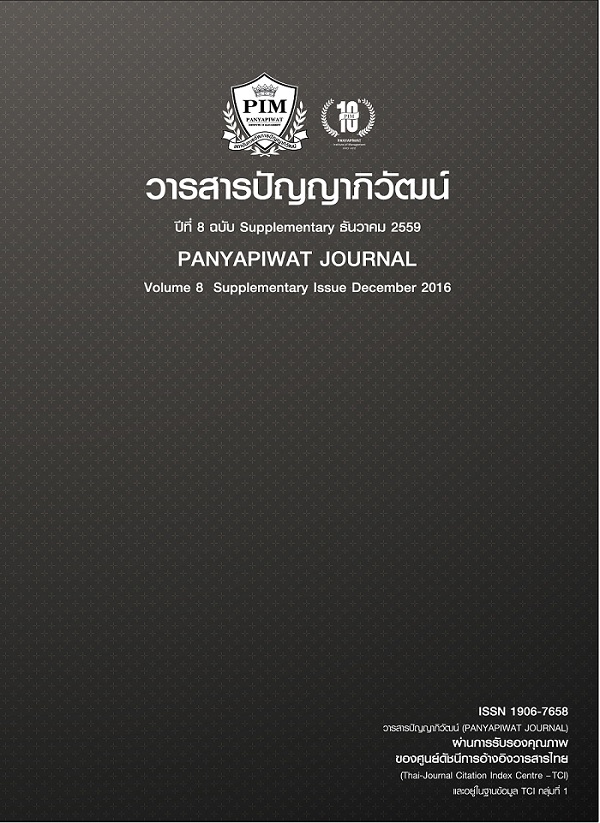BRAND LOYALTY IN LOW-COST AIRLINE OF THAILAND
Main Article Content
บทคัดย่อ
The aviation industry situation is quite intense competition. The most of the airline would like to be the leader and the winner in business war which need to increase the highest loyalty of the customer. Especially, the low-cost airline in Thailand should pay attention in behavior of the customer that effect to brand loyalty of the airline. Therefore, this paper aim to analyzed brand loyalty, brand awareness, perceived quality, brand association and marketing campaign of the low-cost airline in Thailand. The sample of this research is 400 passengers of Air Asia, Nok Air and Thai Lion Air. A survey questionnaire was posted on the internet that links with a low-cost airline social media sites.
The findings of correlation and multiple regression analysis showed that perceived quality, brand association and brand awareness were significant statistically associated and influenced on brand loyalty. For the marketing campaign acted as a single mediator variable which it is no evidence of mediation between perceived quality and brand loyalty, also brand association and brand loyalty too. The model of the analysis in this study could suggest the planning of marketing strategies to create a brand loyalty and expand the customer base in Thailand. Thus, the marketers should consider their brand strategy for building a strong brand in the low-cost airline industry in Thailand.
ในปัจจุบันสถานการณ์อุตสาหกรรมการบินมีการแข่งขันกันค่อนข้างรุนแรง โดยสายการบินส่วนใหญ่ล้วนมีความต้องการเป็นผู้นำและเป็นผู้ชนะในธุรกิจสายการบิน โดยเฉพาะอย่างยิ่งในธุรกิจสายการบินต้นทุนต่ำในประเทศไทย ตราสินค้ามีความสำคัญอย่างยิ่งสำหรับการตัดสินใจใช้บริการสายการบินของลูกค้า ดังนั้นงานวิจัยในครั้งนี้มีวัตถุประสงค์ที่จะตรวจวัดความตระหนักรู้ในตราสินค้า (Brand Awareness) ความเชื่อมโยงตราสินค้า (Brand Association) การรับรู้ถึงคุณภาพ (Perceived Quality) และการส่งเสริมการตลาด (Marketing Campaign) ซึ่งมีผลกระทบต่อความจงรักภักดีในตราสินค้า (Brand Loyalty) ในธุรกิจสายการบินต้นทุนต่ำในประเทศไทย สำหรับกลุ่มตัวอย่างที่ใช้ในการเก็บข้อมูลของงานวิจัยนี้เป็นผู้โดยสารสายการบินแอร์เอเซีย นกแอร์ และไทยไลอ้อนแอร์ จำนวน 400 คน โดยใช้แบบสอบถามออนไลน์และทำการเก็บข้อมูลผ่านสื่อโซเชียลมีเดียของสายการบินดังกล่าว
สำหรับผลการวิเคราะห์ความสัมพันธ์ในแต่ละมิติคุณค่าตราสินค้าด้วยเทคนิคการวิเคราะห์สหสัมพันธ์ และการวิเคราะห์การถดถอยพหุคูณ พบว่า การรับรู้ถึงคุณภาพ ความเชื่อมโยงตราสินค้า และความตระหนักรู้ในตราสินค้า มีความสัมพันธ์และมีอิทธิพลต่อความจงรักภักดีในตราสินค้าอย่างมีนัยสำคัญทางสถิติ ส่วนการส่งเสริมการตลาด (Marketing Campaign) ซึ่งเป็นตัวแปรคั่นกลางที่ไม่พบหลักฐานการส่งผ่านความสัมพันธ์ระหว่างการรับรู้ถึงคุณภาพ และความเชื่อมโยงตราสินค้าต่อความจงรักภักดีในตราสินค้า ซึ่งตัวแบบ (Model) ของการวิเคราะห์ในงานวิจัยนี้สามารถนำไปใช้เป็นตัวชี้นำในการวางแผนกลยุทธ์ทางการตลาดที่จะสร้างความจงรักภักดีของตราสินค้า และขยายฐานลูกค้าให้เพิ่มขึ้นได้ ดังนั้นนักการตลาดควรที่จะพิจารณา และให้ความสำคัญในกลยุทธ์ตราสินค้าของสายการบินเพื่อที่จะสร้างความเข้มแข็งของตราสินค้าในธุรกิจสายการบินต้นทุนต่ำในประเทศไทย
Article Details
“ข้าพเจ้าและผู้เขียนร่วม (ถ้ามี) ขอรับรองว่า บทความที่เสนอมานี้ยังไม่เคยได้รับการตีพิมพ์และไม่ได้อยู่ระหว่างกระบวนการพิจารณาลงตีพิมพ์ในวารสารหรือแหล่งเผยแพร่อื่นใด ข้าพเจ้าและผู้เขียนร่วมยอมรับหลักเกณฑ์การพิจารณาต้นฉบับ ทั้งยินยอมให้กองบรรณาธิการมีสิทธิ์พิจารณาและตรวจแก้ต้นฉบับได้ตามที่เห็นสมควร พร้อมนี้ขอมอบลิขสิทธิ์บทความที่ได้รับการตีพิมพ์ให้แก่สถาบันการจัดการปัญญาภิวัฒน์หากมีการฟ้องร้องเรื่องการละเมิดลิขสิทธิ์เกี่ยวกับภาพ กราฟ ข้อความส่วนใดส่วนหนึ่งและ/หรือข้อคิดเห็นที่ปรากฏในบทความข้าพเจ้าและผู้เขียนร่วมยินยอมรับผิดชอบแต่เพียงฝ่ายเดียว”
เอกสารอ้างอิง
Aaker, D. A. & Joachimsthaler, E. (2000). Brand Leadership. London: Free Press.
Aaker, D. A. (1991). Managing Brand Equity: Capitalizing on the Value of a Brand Name. NY.: The Free Press.
Alamro, A. & Rowley, J. (2011). Antecedents of brand preference for mobile telecommunications services. Journal of Product & Brand Management, 20(6), 475-486.
Asamoah, E. S. (2014). Customer based brand equity (CBBE) and the competitive performance of SMEs in Ghana. Journal of Small Business and Enterprise Development, 21(1), 117-131.
Aurier, P. & de Lanauze, G. S. (2011). Impacts of in-store manufacturer brand expression on perceived value, relationship quality and attitudinal loyalty. International. Journal of Retail & Distribution Management, 39(11), 810-835.
Cochran, W. G. (1963). Sampling Techniques (2nd ed.). New York: John Wiley and Sons.
Jung, H. J., Lee, Y., Kim, H. J. & Yang, H. (2014). Impacts of Country Images on Luxury Fashion Brand: Facilitating with the Brand Resonance Model. Journal of Fashion Marketing & Management,18(2), 187-205.
Keller, K. L. (1998). Strategic Brand Management. Upper Saddle River, NJ: Prentice-Hall.Keller, K. L. (2003). Strategic Brand Management: Building, Measuring, and Managing Brand Equity (2nd ed.). Englewood Cliffs, NJ.: Prentice Hall.
Keller, K. L. (2008). Strategic Brand Management: Building, Measuring, and Managing Brand Equity (3nd ed.). Pearson Education: Prentice Hall.
Kotler, P. (1997). Marketing Management: Analysis Planning Implementation and Control. New Jersey: Prentice-Hall.
Likert, R. (1932). A Technique for the Measurement of Attitudes. Archives of Psychology No.140, 1-55.
Nguyen, T. D., Barrett, N. J. & Miller, K. E. (2011). Brand loyalty in emerging markets. Marketing Intelligence & Planning,29(3), 222-232.
Parsa, A., Eidelou, P. H., Abdolahi, S., Maleki, M. & Mehrabi, S. (2013). A Review of the Affecting Factors on Brand Equity from the Customer Perspective (By Using Aker Views). Interdisciplinary Journal of Contemporary Research in Business,4(11), 712-719.
Pitsaphol, C. (2015). The influence of brand equity on marketing performance of SAMSUNG and OPPO in Thailand. Doctoral dissertation, School of Management, Huazhong University of Science and Technology.
Schiffman, L. G. & Kanuk, L. L. (2004). Consumer behavior. New Jersey: Prentice Hall.
Severi, E. & Ling, K. C. (2013). The Mediating Effects of Brand Association, Brand Loyalty, Brand Image and Perceived Quality on Brand Equity. Asian Social Science, 9(3), 125-137.
Shabbir, R., Zhang, J., Pitsaphol, C. & Hassan, W. (2015). The Dynamics of Value Creation in Online Brand Communities: Strategy Map Approach. Information Management and Business Review,7(1), 48-58.
Yaseen, N., Tahira, M., Gulzar, A. & Anwar, A. (2011). Quality and Customer Loyalty on Brand Profitability and Purchase Intention: A Resellers’ View. Interdisciplinary Journal of Contemporary Research in Business, 3(8), 833-839.
Yoo B. & Donthu, N. (2001). Developing and validating multidimensional consumer-based brand equity scale. Journal of Business Research, 52(1), 1-14.
Zhang, J., Pitsaphol, C. & Shabbir, R. (2014). The Influence of Brand awareness, Brand image and Perceive quality on Brand loyalty: A Case Study of OPPO Brand in THAILAND. Interdisciplinary Journal of Contemporary Research in Business,5(12), 10-21.


